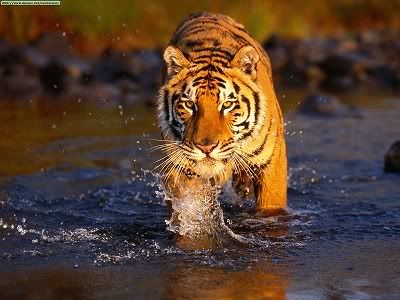
Living largely secretive life and attacking preys using stealth, cunning and agility, a tiger is mostly considered a villain (like Sher Khan in Kipling’s Jungle Book).
Moreover, the man-eaters in India have further maligned the image of a tiger. Not much is still known about the lives of the tigers in the wild and hence a lot of the information considered as ‘facts’ about tigers are merely informed guesses.
Since the chance of encountering a tiger in the wild is way less than the chance of encountering a wild lion, a lot of data about tigers reflect either only a small population of them, or are based on indirect studies, or both. Also, a tiger’s unwillingness to fight without necessity has often been seen as lack of courage and aggression.
Vital Statistics:
[There are a lot of variation in the figures found online.
* Largest Siberian Tiger found in the wild : 845 lbs/ 384 kg.
* Longest Siberian Tiger found in the wild: 12′9″/ 3.9 m
* Largest Bengal Tiger found in the wild: 857 lbs/ 389 kg. 3.22 m 10 ft 7 in between pegs (3.37 m 11ft over the curves)
*(The largest tiger ever held in captivity, and the heaviest ‘natural big cat’ on record, is a nine-year-old male Siberian named ‘Jaipur’, owned by animal trainer Joan Byron-Marasek of Clarksburg, New Jersey, USA. This tiger measured 3.32 m 10 ft 11in in total length and weiged 423 kg 932 lb in October 1986)
* Average size (mode) of Siberian Tigers living in the wild: 550 lbs (250 kg) and 11′/ 3.35 m
* Average size (mode) of Bengal Tigers living in the wild: 500 lbs (227 kg) and 9′6″/ 2.9 m (Bengal tigers have a slightly shorter tail than the Siberians)
** The Bengal Tigers have the longest canines **
The Greatest Cat:
Tigers vary in size as well as in aggressiveness (supposedly, at least), not only across different sub-species but also depending on the region they inhabit. Bengal tigers found in Nepal, Bhutan and in Assam, Uttaranchal & West Bengal (Northern part) states in India (collectively, the tigers of the Terrai and Duars) are larger than Bengal tigers found in Sunderbans and Rajasthan.
The Sumatran tigers are supposedly the fiercest but they are the smallest sub-species of tigers. The Siberian tigesr are the biggest, but considered to be less agile and less aggressive than a Bengal tiger. The Bengal tigers are most widely touted as the most skillful and overall best breed of tigers – nearly as big (male ~230 Kg, ~3 m) as the Siberian ones but much more fierce, agile and strong.
The Bengal tigers of the Terrai are often bigger than average Siberian tigers
Relative Advantages Over a Lion:
1.Longer and often larger size. Now this is often posed by the people who pick a tiger to win, as a serious threat to a lion. A larger yet more agile body of a tiger is really a serious threat to a lion. But this alone can not be a decisive factor.
2.More powerful back legs. This helps a tiger to leap more, to spring from a disadvantageous position and to make sudden moves. This is of tremendous advantage to the tiger. This gives the tiger the ability to rest its weight on the hind legs and make swipes with both of the front legs. Plus, the strong hindquarters allow them to attack from the side and spring from unexpected/disadvantageous corners. Moreover, a tiger makes faster swipes than a lion. Tigers are more agile than lions.
3.Skills of ambush attacking, tree-climbing, swimming etc are handy if the going gets tough. Plus, tigers are faster runners. These are all defence mechanisms for a tiger just as the mane is for a lion.
4.Longer canines, longer claws and larger paws. These are the ultimate weapons of a cat. Tigers have considerable advantage here.
Amazing Tiger video:
3.15 sec - Watch rare video footage of tiger's amazing vertical leap.
WARNING: Watch with discretion! Graphic scenes of tigers' deadly attack.





























 !
!















No comments:
Post a Comment